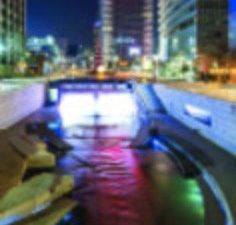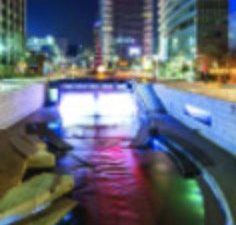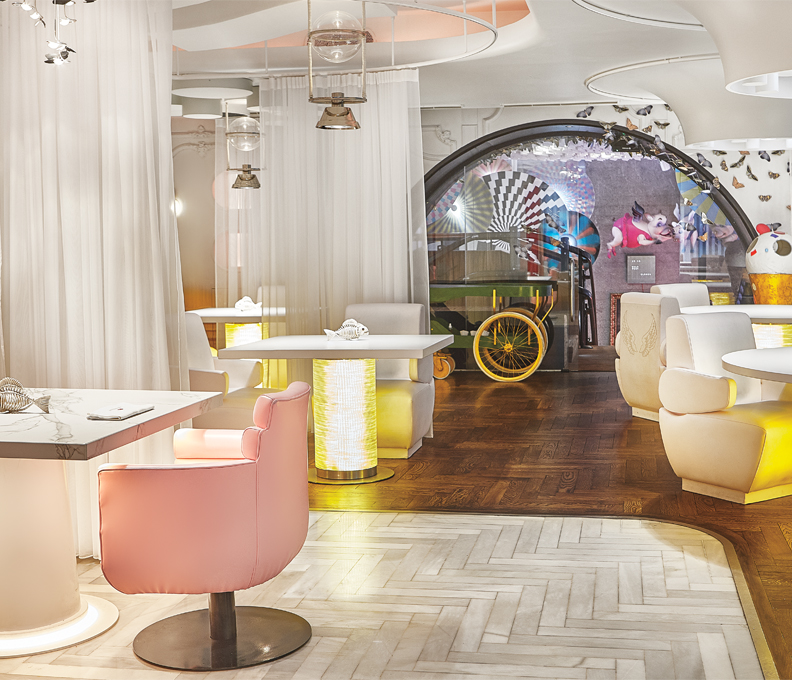A river runs through it
March 31, 2017

Seoul’s recent history has been marked by rapid modernization, an eager acceptance of technological advances and urban growth on an impressive scale. Now a huge, sprawling conurbation, many of its highest-profile developments can be found south of Hangang (Han River): the 123-story Lotte World Tower is the highest building in Korea at 1824 feet, and there are expansion plans for the COEX district too, where Hyundai has purchased a huge plot of land opposite the enormous convention and shopping center, and plans to build hotels, more events and retail space, etc.
However, in the city’s CBD, located within the historic city walls of Seoul north of the Han, plenty of growth is happening too – albeit in a less grandiose fashion. By using a relatively recent – and now much appreciated – addition to the city’s impressive collection of parks, it’s possible to bisect the busy, skyscraper-filled downtown area, and get a sense of Seoul’s multi-faceted appeal.
Historical Source
In Korea’s pre-industrial era, when Seoul was a fraction of its current size, a stream meandered through its center. Its name was Cheonggyecheon – today it is commonly referred to simply as “the Stream.”
After the Korean War, however, things changed: the Stream became lined with shantytowns and increasingly polluted and dirty. In 1958 a road was built over it, followed by an elevated freeway in 1976. The once iconic Stream was gradually forgotten in the rush towards an industrialized future, and the whole area became something of an eyesore.
At the turn of the millennium Lee Myung-bak, whose construction company had actually built the freeway, made restoring the Stream a major part of his campaign to become Seoul’s mayor. (Lee went on to become the country’s president.) In 2003, as city mayor, he gave the green light for the $360 million reclamation project to begin: the freeway was torn down, the surface road ripped up, and pumping stations installed to bring 30 million gallons of water from the Han River, ensuring a regular flow that the original stream never had.
Cheonggyecheon reopened to the public in 2005 as a linear parkway that stretches from Cheonggye Plaza all the way through central Seoul to Dongdaemun and beyond. Set below street level, more than 20 bridges span the Stream’s total length; its walking paths and walls are concrete or stone – though trees have been planted in many stretches to offset this apparent “green space” contradiction.
Initial reaction to the park was mixed – but worries about traffic problems were addressed by extensive rerouting schemes, dedicated bus lanes and improvements to public transport. When it became clear the revitalization project had improved air pollution, had a genuine cooling effect on the CBD in summer, and boosted biodiversity, everyone was won over.
“Cheonggyecheon is one of our biggest success stories. We realized the city did have a lot of concrete and the time had come to revitalize it,” says Maureen O’Crowley, executive director of tourism and MICE division, Seoul Convention Bureau (SCB).
However, just as important as the Stream’s aesthetic beauty is the fact that it has been a catalyst for economic development in the CBD. Construction of high-rise buildings is forging ahead in the blocks flanking the western section of the Stream – and many of the office workers who fill these buildings like nothing better than to take their lunch down to the Stream. Koreans have an innate love and respect for nature, and Cheonggyecheon offers precious respite from city stress.
A Walk on the Gentle Side
I decide to trace the Stream’s first two and a half-miles as far as Dongdaemun, with occasional forays north and south into the surrounding districts. (The Stream itself continues on for the same distance after Dongdaemun, curving round to the south and eventually flowing back into the Han River.)
I start at Cheonggye Plaza, a modest square that backs onto the broad south-north boulevard from Seoul Plaza up to Gwanghwamun Square and Gyeongbokgung Palace – the main home of the Joseon dynastic rulers and arguably Seoul’s most impressive palace. This wide road leads down to City Hall, Seoul Plaza and some of Seoul’s top hotels.
In the square stands a spiraling statue that could be a seashell or a unicorn’s horn. Above it rises the rectangular block of the Seoul Finance Centre. The Stream begins in style, with a 10-foot waterfall that is backlit in various colors at night. A wishing well close to the first bridge tempts visitors to toss coins – all for a good cause, as the money is collected regularly and given to charity.
The second bridge, Gwangtonggyo, uses great granite blocks, Stonehenge style, some with ancient carvings of clouds and Buddhist symbols. After that comes Gwanggyo bridge, across which a busy road carries incessant lines of traffic.
Turn left and one block north is a large crossroads with two classic examples of ancient and modern Korean architecture: Bosingak is a beautiful old bell tower whose 15th-century bell was used to signal the opening and closing of Seoul’s four great gates, while directly across the road rises Jongno Tower, a triangular glass and steel edifice topped by a “floating” oval summit. One of the most distinctive modern buildings in Seoul, it is owned by Samsung, one of Korea’s great chaebol conglomerates (others include Hyundai, LG, Hanwha and Lotte) that still wield great economic power in the country through diversified holdings in a wide range of industries.
Turn south from Gwanggyo and you are quickly engulfed in the shopping mania that is Myeongdong, Seoul’s tourist retail district and one of its busiest precincts. The warren of small streets is packed with brand outlets and souvenir stalls.
Back in the peaceful environment of Cheonggyecheon, between the bridges, stepping stones cross the Stream – a fine source of youthful high jinx and photo ops. Dozens of small rapids provide a restful counterpoint to the dissonance of the busy city above.
North of this section is Insadong, Seoul’s arts and crafts district, where traditional restaurants and teahouses share the alleyways with art galleries and more souvenir stalls than you can shake a stick at.
Samil-gyo is the beginning of the end of the CBD’s skyscrapers; from here to Dongdaemun the Stream is flanked by low-rise buildings. In the water carp and a host of other species swim, preyed upon by herons and other fishing birds. The water is crystal clear and not a single item of rubbish lies on the ground. Now you pass the labyrinthine covered markets of Gwangjang and Dongdaemun markets, whose stalls are stuffed with household items, foodstuffs, trinkets and much more.
My walk ends at Dongdaemun; to the left is JW Marriott Dongdaemun Square, opened in 2014, the attractive 170-room hotel sits right by the Stream.
Turn left and ancient Heunginjimun Gate looms in front of you, but turn right and a monument to the modern world stands even taller. This is Dongdaemun Design Plaza (DDP), a curving, spaceship-like construction designed by the late Zaha Hadid. It opened two years ago, a mix of conference halls, design shops, a museum and culture park.
The surrounding area is Seoul’s fashion district, and it’s a popular place for events. The land next to DDP is now owned by Seoul City, which plans to develop it with more hotels and retail space – the city’s planners never sleep.
Accommodation Acceleration
The same could be said for the hotel groups, both Korean and international, which are busy upgrading existing properties and launching new ones throughout downtown Seoul. Some of Seoul’s best-known hotels, including the Lotte Hotel, the Westin Chosun, the Koreana and The Plaza Seoul – now a member of Marriott’s Autograph Collection – can be found around City Hall and the boulevard up to Gwanghwamun Square.
However, the launch of the new-build, 317-room Four Seasons Seoul just over the road from Cheonggye Plaza in October 2015 has shaken up the luxury market and given new impetus to this part of the city. “We have a large number of hotels becoming active, including five stars like Four Seasons, but more in the four-star segment that are looking primarily at the Chinese tourism market,” SCB’s O’Crowley says.
Indeed, while top-end Korean hotels are strategically linking with international brands to leverage their online presence and loyalty program benefits – The Plaza’s partnership with Marriott, the Grand Ambassador Seoul in association with Pullman and having close ties with Accorhotels, and in Gangnam with the Sheraton Seoul Palace – most of downtown’s new properties are in the “business premium” sector.
A good example is the new 383-room Shilla Stay Gwanghwamun, which opened in December 2015 just north of Cheonggyecheon. A new brand for the Shilla group, it is one of five now in Seoul, its minimalist, trendy style targeting corporate travelers.
Another trend-setting new hotel brand by a Korean hotel giant is Lotte L7, located in Myeongdong (as is the Lotte City Hotel) but focusing on Millennials. It boasts an eye-catching mural on its outside façade, cool gray tones similar to the Shilla Stay’s, and funky wall collages of random bright-yellow, plastic-coated items such as skateboards, typewriters and rucksacks. The hotel also offers pedicab rides on three routes around the city center, one of which includes the Stream.
A host of international brands also have a presence in central Seoul, including Courtyard by Marriott, Ibis Ambassador, Best Western New Seoul and Best Western Premier Kukdo, and Starwood’s 223-room Aloft Seoul Myeongdong which opened in February.
It all adds up to a real sense of expectation and optimism in downtown Seoul’s appeal for international leisure visitors but also for corporate travel and the events market. Mainland China is of course a major reason for this optimism. “Korean pop culture has really caught on [in China], and we are neighbors so there’s a natural business connection,” says O’Crowley. “From China we have the most attraction with incentives, though there is rising awareness coming out of Indonesia, Malaysia, Taiwan and Vietnam.”
Wherever the city’s visitors are coming from, and whatever their reasons for coming, Seoul’s future, like the water of Cheonggyecheon, seems bright and clear.
By Jeremy Tredinnick




